
The story of a small Filipino nightclub that transformed into one of San Francisco’s most influential punk venues.
“To play, you need a place – be it where you live, the street, a venue. For unrestricted play, you need an unrestricted playground. Dirk Dirksen envisioned The Fab Mab just as such a playground. Without him and The Mab, there might not have been the great punk scene in the late 1970s in San Francisco. The San Francisco punk scene was fun. I miss it. But as Iggy Pop said, ‘Let’s Sing.'”
— Mindy Bagdon
Special thanks to Denise Demise Dunne, Liz Keim, Penelope Houston, Ron Greco, John Seabury, V Vale, Janet Clyde, and Kathy Peck.
The archival interview with Dirk Dirksen is from Vale’s RE/Search Conversations 13.
Production support from Mary Franklin Harvin.
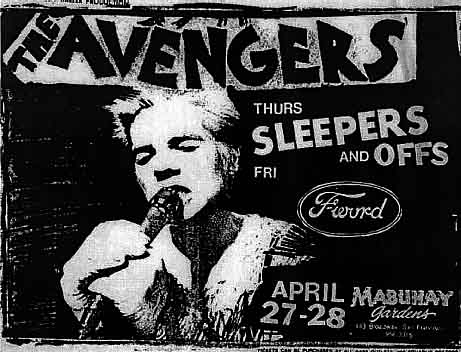
From Pinoy to Punk: The Rise of The Mabuhay Gardens
An Oral History of San Francisco's Early Punk Scene
Penelope Houston (PH): The Mabuhay was not your average rock club.
Denise Demise Dunne (DDD): Here was this little club all of a sudden attracting the energy.
Ron Greco (RG): The Dills, Negative Trend, The Avengers…
DDD: So of course you are going to say, Oh, what is going on over there.
PH: More and more people started coming to town. The Ramones played there. Blondie played there. It just became the punk mecca.
RG: When I was real young, I would go by and see this place. It was there for years.
DDD: Dirk was helping Ness with the Amapola show. Amapola was this Filipino night club singer and she was popular within the Filipino community and had a TV show on Channel 26 and a number of characters from The Mab had performed there. My name is Denise Demise Dunne. I was Dirk’s assistant at the very beginning of The Mab.
V Vale (VV): Hi, welcome to The Counter Culture Hour. I’m your host V Vale and I published starting in ‘77 Search and Destroy, the punk publication chronicling the rise of the punk rock cultural revolution. My guest tonight is Dirk Dirksen, the impresario of The Mabuhay Gardens.
LINK: RE/Search Publications
Dirk Dirksen: We were open for ten years, did 3,600 plus concerts.
VV: The thing was at the time things were so conservative that no club wanted anything to do with punk rock until Dirk Dirksen showed up and made The Mabuhay Gardens available.
DD: Ness downstairs at The Mabuhay was having a tough go of it, so I came in and said, Look – how about if you give us Monday nights because that is your dark night. Let me try that and I will guarantee you $175 a night at the bar. I didn’t have $175 at the time, but I figured there are enough people I know that if I say hey, c’mon down and if they each drink two beers, we’ll meet the guarantee. And within a very short time we were grossing more on the Monday than he was grossing on the weekend with name Filipino acts.
Mindy Bagdon (MB): My name is Mindy Bagdon. My film’s name is “Louder Faster Shorter”. At one point on Mondays, which was a dead period on the Broadway strip, Dirk convinced Ness Aquino who owned the club to let him put on different acts. Little by little, it went from sort of vaudevillian variety acts to where The Nuns, who were one of the first groups to play there, apparently they went up to Dirk and they found out this venue was available and they said, Well can we put on a show? And I remember I was walking up Grant Avenue and Vale’s then girlfriend was coming down and proceeding me was the drummer for The Nuns and he was handing out flyers.
VV: My girlfriend who looked like a rocker – I guess I looked like one too, you know with platform shoes and spiked hair and all that junk, just superficial style – my girlfriend was walking down the street and a really short guy said, Hey…feel like coming to our band’s debut at The Mabuhay Gardens, which none of us had heard of because it was Filipino. I’ll put you on the guest list! Those are the magic words for any so-called real punk rocker. So we went and then the rest is history.
MB: The first time we went to The Mabuhay there were more people on stage than there were in the audience, because it hadn’t gotten around. But within two weeks it was packed. I mean, word got around town. Don’t forget this is before the internet, before smart phones, it was literally person-to-person or on the telephone or snail mail to say this venue was doing this. And like I said, within two weeks it was jammed. The joke was Bruce Conner, the famous artist, said – You’d be watching a band and you said, well I can do this too. So you’d go home and learn at least one chord on your bass and you’d get on the stand and you were the audience one week and now you are on the stage.

Kathy Peck (KP): I’m Kathy Peck, bass player for The Contractions and the co-founder and executive director of H.E.A.R, Hearing Education Awareness for Rockers. I came here with Don Peck and he was playing drums with Mary Monday. She actually started the punk scene at The Mabuhay Gardens. She was like the first one. There were other people that played there but she was the one that really…she was amazing.
MUSIC: Mary Monday, I Gave My Punk Jacket to Rickie
KP: She came from a dancer background, but she was really punk. She was just wild! And I would hear stuff at The Mab and see it being played. I loved the music. I got inspired by Mary and I had a bass – a Hofner Beatle bass. I was learning to play. I was self-taught. Yeah, it was really exciting. People were like, they call it pogo-ing or whatever, slam dancing. It was like very crowded and electrifying.
DDD: Dirk at that point asked me to be his assistant and it was like, Yeah, but I can’t type. Because I basically avoided typing because as a female you get pigeoned holed into being someone’s assistant. And he said, Well you don’t have to type that much and you get to do a lot of things around there.
John Seabury (JS): Pretty often during the evening he would be wearing what looks like the Groucho Marx nose with the glasses and eyebrows, except this one had a dildo instead of a nose.
DDD: Mustache, glasses, a bit overweight. I remember the beige jacket, the beret on his hair, and the poodle in his arms. The was the first time I met Dirk.
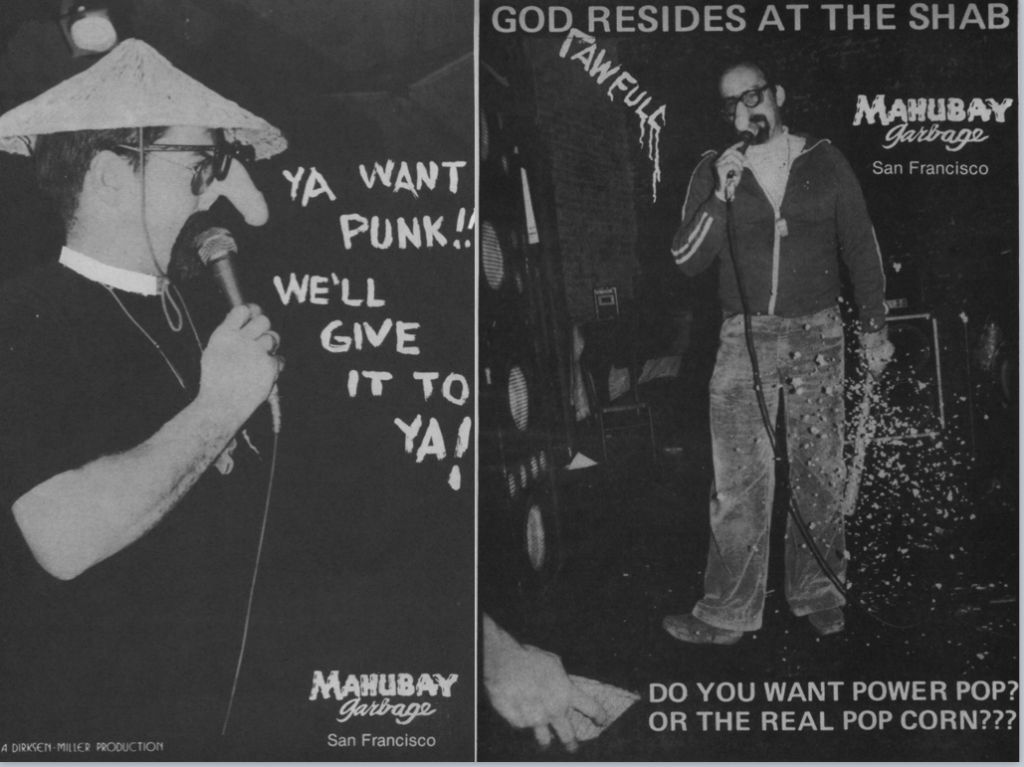
JS: At the end of the evenings of course, he’d come out on stage and tell everyone to get out which no one is ever paying attention to. So he had a real police whistle which he would blow as hard as he could through the PA til people would leave. His favorite line was “We can’t make anymore money off you, so get out!” I’m John Seabury. I started out playing in a band Psychotic Pineapple back in the 70s and I’m a graphic artist. I did all of the graphics for the band.

RG: I went to this nightclub called The Night Break, I guess you go downstairs on Columbus. This guy walks up to me. This big eye ball t-shirt and this big chicken hawk hair, red flaming hair, and he looks at me and says, Do you play guitar? And I say yeah. And so we talk for a little bit and within 30 days we each get Marshall stacks. That’s how quick it was. Zoom, zoom, zoom. Before we were Crime we were the Space Invaders. Ron Greco, Ron “The Ripper” Greco. I had a Gibson Ripper Bass and everybody goes – Man, you rip a lot! Ripper!
DDD: I took the job and would come in and help him go through all the paperwork. Listen to some of the demo tapes of the bands that came in. Get their press announcement, like Devo. I still remember it saying, Achtung, De-Revolution has begun!
RG: I got the band members together and said, Let’s walk in and talk to the owner. We had a good time there talking to him and so we arranged a show to play.
MUSIC: Crime, Live at The Mabuhay Dec 1978
PH: In 1977 I moved down to San Francisco to go to the Art Institute in North Beach. And after I got there I started to see these posters around town for this band called Crime. And they were really intriguing posters and they weren’t like anything I’d ever seen. They were at a club called The Mabuhay. I was 19 at the time but they let people in 18 or older but they let people in because it was also a Filipino restaurant, so they were able to let minors in. My name is Penelope Houston, I’m in a band called The Avengers. We started in 1977. That was my first band. I’d been going to these shows and ran into Danny Furious who ended up being The Avengers drummer. He had a friend in Los Angeles, Greg Ingraham, and he brought Greg to SF to be in a band with him. Danny had rented part of a warehouse out in Dogpatch and they had a PA set up for their rehearsals. I was staying over there one day hanging out and everybody was gone and I put on some records and started singing through the PA. I just fell in love with the power of amplification. I was like, this is so awesome. I’m so loud and then when they got back I said, I’m going to be your singer.
Liz Keim (LK): When I found the club, I felt at home. I could be exactly who I was and still be part of it. I was freed. My name is Liz Keim and along with Karen Merchant, we created the film, In The Red. It’s a punk document of the late 1970s mostly filmed at The Mab. For the last 40 years, I’ve also been working at the Exploratorium. I’ve been the director of the Cinema Arts program and I’m one of the senior curators.
WATCH: Ears, Eyes and Throats: Restored Classic and Lost Punk Films 1976-1981
DDD: Oh, it was fabulous. There were people that came in for the first time to explore and they were still looking hippie. Then there were folks who had taken on the persona. Leather jacket, jeans, black pants, ripped t-shirts. You’d walk down the corridor and there were all these little crevices with people hanging out there.
LK: You’re a night creature, looking for that place to be that feels like home.
DDD: I was one of those creatures cuz you’re just kind of there and you’re watching.
LK: I went up to UC Davis to study art and that was a kind of isolating experience, when I came back into San Francisco I was looking for an intimacy in some ways. Looking for those smaller landscapes. I started filming. I prefer observing and critically assessing where I’m at and I was drawn to the experimental film genre so I wasn’t looking for something that followed a bell-curve narrative or you know was scripted outside of any experience I was living in. So for me it was just capturing a kind of way of being in San Francisco. There were all kinds of relationships that didn’t have to feel permanent where you didn’t have to have names, there was just something about a recognition.
DDD: There was just this excitement. There was the energy back to that word.
LK: It was about being in the mosh pit. It was about hanging on to someone I didn’t know just for counterbalance and it was fine because my counterbalance was as into me as a counterbalance as I was into him or her as a counterbalance. You didn’t have to talk. You know, in some ways we just talked through our bodies. Maybe The Mab was an analog experience for me.
DDD: I was at KSAN at that point and Lou Reed came in for an interview, he was playing at the Old Waldorf. And he brought this guy in with him and the DJ didn’t want to deal with him and said, well, show him around. So we are talking and I’m showing him around and I’m telling this guy about The Mab and what’s going on cuz Lou has his show and I said, Oh, I’ll take you there. You know, and this was Jim Carroll.
JS: Once we got in The Mabuhay, Dirk was really good to us. He had the sense of humor, he kind of got us. So somethings he would have us open for someone really inappropriate like the Jim Carroll Band or somebody like that just because he was being perverse about it. We opened for Jim Carroll twice. And the second time word was out that Patti Smith was in town playing the Old Waldorf and she is probably going to show up and jam. So the Mabuhay was double packed that night.
DDD: Patti Smith, Patti Smith, Patti Smith!
JS: After the set we were backstage and Dirk comes up and goes, Hey you know, Patti Smith is coming. We were like, Yeah yeah, we heard. Well she needs to borrow a guitar and we were like – No! Because we know she is going to break the guitar.
DDD: When Patti played The Mab, it was mesmerizing.
JS: Of course most of the players in the scene at the time would have run home and gotten a guitar just to give to her to smash. Dirk goes off and he comes back ten minutes later and goes, Please guys, please….really, just one guitar for Patti. And we were like, No – forget it! So the band was on and Patti did show up and it was really mobbed and all I could see of the band was the tops of their heads and then I just see the guitar overhead going smash, smash, smash and that was it. And it’s probably in a museum somewhere now.
DDD: It was awestruck. Like, wow! I mean, these are stupid words to come up with because it was just there and here’s this persona mixing this punk with poetry. It was like, yeah, this is it. This is just taking it to a whole different level. Because there were so many levels. There was the fun part, there was the political part, and here is the poetry – here is the art.
LK: Hanging outside was like the preamble or whatever. You got your sense of whether it was going to be crowded and what the energy was like. You didn’t just rush in. It was a lingering. The kind of slow meander and then you would hope to just squeeze in and get by admissions. And maybe having enough money for a beer.
ARCHIVE: PUNK TV SPECIAL, San Francisco Daytime Show “People Are Talking”
MB: Early on people would throw beer bottles at the stage and that was very dangerous. So they actually thought maybe we will put a screen up between the band and the audience but that didn’t sound like a good idea. So then he got the idea, Ah ha – I’m going to make 55 gallon drums of popcorn!
VV: All the super salty popcorn you could eat. I realize later the theory is that this makes you buy drinks.
JS: Free popcorn on the tables. It was really old popcorn and it wasn’t for eating – it was for throwing at the bands.
PH: There would be this big mess of popcorn and jumbled chairs and tables knocked over and it was kind of like a disaster zone.
DDD: I remember being in my house and all of a sudden just having this paradigm shift. The music was playing and all of a sudden, WHAP! Like – reality is not the same anymore.
MUSIC: The Ramones – Judy Is A Punk
DDD: All of a sudden something woke up inside of me. I didn’t even know what it was called at that time but it was like, Oh, something – something just changed here.
LK: Not having much money it was like how to get into these places without it. You could sometimes climb in through the front window at The Mab and one time someone came and grabbed me and said, Dirk wants to talk to you in his office. So he goes, You don’t think I see you sneaking in all of the time! You know, no more of that. But it didn’t stop you. It was part of the culture. We were there to just get it however we could.
WATCH: Louder Faster Shorter, by Mindy Bagdon
PH: The first show we played at The Mab, we had been asked two weeks before if we would play this show – an after party for The Nuns. Between when we heard about the gig and when we played it we went to LA and were visiting with friends of mine from Seattle, The Screamers. Tomato DePlenty and Tommy Gear. And I remember Tommy and Tomato saying to me, Oh you can’t do cover songs. You guys need to write your own songs. So we got back from LA and we had about a week to go and were like, alright let’s write some original songs. So we sat down and wrote “Car Crash”, “I Believe in Me”, “Teenage Rebel” – maybe six songs, original songs, in that week. Then when we got up to play our first time on a real stage in front of a real audience – for me anyway – and someone had written the setlist wrong and so the guitar player was playing a different song from the bass player and the drummer. And when the music started, I was like, Oh my god. Oh my god. I can’t do this. I don’t even know what song this is. It just sounds like a big mish mash. I can’t remember the lyrics and I was so confused and we stopped playing a few seconds later and was like what? What song are we playing? And then they figured it out and we started playing the same song and I was like, Alright, Okay. Here’s how it goes and I can actually do this. But for ten long seconds there I thought, Oh, it’s all gone out of my head. I can’t do this. This is a nightmare. So then we just piled through the set and some people who were there were like, that was really amazing. And we were like, Oh my god. That was such a car crash.
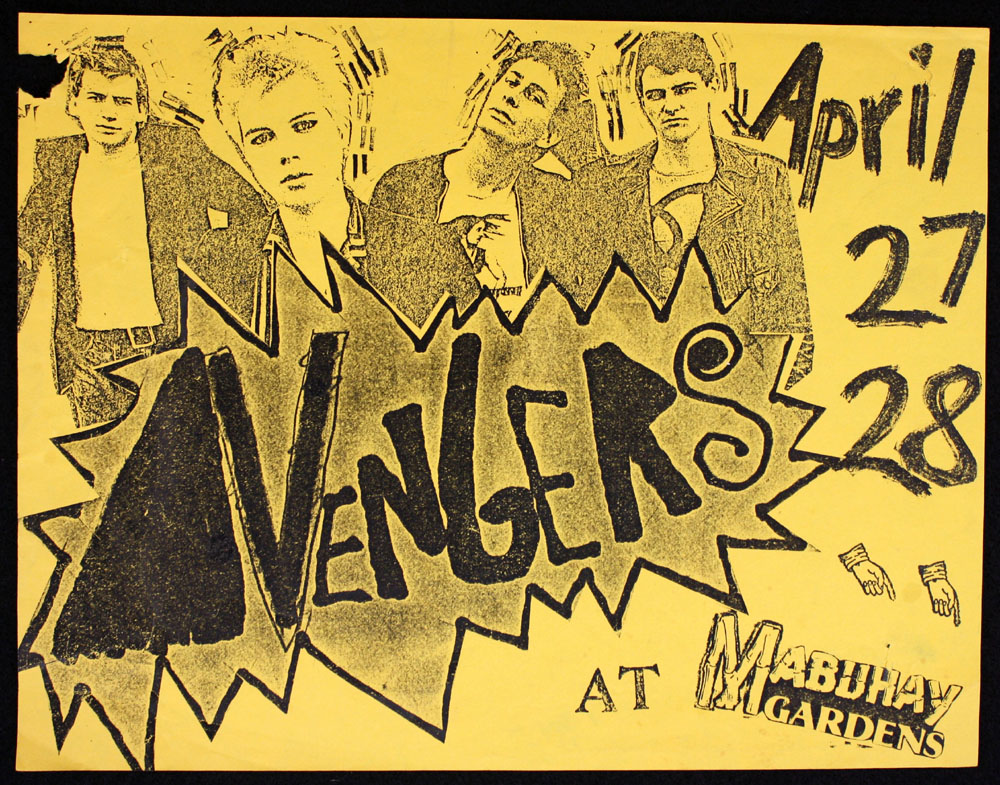
PH: January 14, 1978 we’d been invited to support the [Sex] Pistols. We got there and the place was absolutely sold out. Between five and six thousand people. The biggest show The Sex Pistols ever played and like ten times bigger than the biggest show we’d ever played. So when The Nuns were up there performing the stage got covered in things people were throwing, and spit, it was just pretty rough. So we walked out after they were done to take our place on stage and the first thing that happened to me was I slipped on the stage because there was so much spit. And I almost hit the ground but I kind of caught myself and made my way carefully to my microphone. There is a video of the whole night. And you can see how when we start we were a little frightened and shaky and scared. And then as are set progressed we just got more and more confident and got stronger til at the end we were feeling pretty awesome. It was crazy because there were so many people there and they were all mashed together. People were getting squeezed out of the audience like pimples. And passed overhead like they were passing out. You’d look out at the sea of faces and see someone you knew and make eye contact with them and a second later they would disappear into the crowd. So it was intense, especially for us. We were used to seeing a lot of our friends right up front singing along with us and this was like a huge number of people who had never seen punk before and were there for the spectacle. You know, the circus. A lot of people out there, it was a pretty intense experience. I think the throwing of things increased when the Sex Pistols got out there because Johnny Rotten egged them on. Someone threw a camera on stage. He was like, Oh, thank you. Like he was really egging them on to throw stuff. It started out terrifying for us and ended up feeling very good. There were rumors that Sid’s bass was not even plugged in for that set. And I guess I would have to go back and listen to it to see if I could tell, but I think the band was pretty used to making their way through the set without counting on him.
Janet Clyde (JC): I’m Janet Clyde. I am one of the owners of Vesuvio Cafe in North Beach. I moved here in 1978 when I was 21. I got my first job in San Francisco at The Mabuhay Gardens. I knew how to waitress, I knew how to cocktail, and so it was basically pick up a tray. Dirk right there, he would be at the front insulting people – What are you wearing, rat fur? He was just the funniest guy. Never took himself or anybody too seriously. And really good to the bands, like really good. You’d come in and it was this long, rectangular room with a low ceiling. Dark, cave like – really dark – barebones, tables and chairs, bar in the back. You’d walk in and in the front a stage that was only a few feet high. And there was a back seating area that was raised a little bit.
VV: After they removed all of the tables and chairs and seating and all that junk then a lot more people could fit in. Legally you could maybe cram in 200 people. The most crowded night I remember was some show with both Iggy, Blondie, and David Bowie were there in the audience. And somehow everyone found out about it and that was the most crowded I’ve ever seen The Mabuhay.
JC: We’d go in at 10. There would be no one there at 10 at night, nobody there. But by 11-11:30 it would be packed! And I saw 999, Lene Lovich – I mean, more people than I can count – SVT! It was so much fun, so much fun! Two people stand out – waiting on Bill Graham, who terrified me – and waiting on The Clash, who also terrified me! The Clash though, when Joe Strummer is asking you for a beer and you are just like, Okay, and giving you money and you are trying to think about how to make change for this. Like, my brain has just disappeared. It was amazing! He gave me a $50 bill for the beers. I gave him back like $150 in change. I just could not count – I could not think! And the manager, I will never forget, he just took the money out of Strummer’s hand, put the money back into my hand. And then like you would with a child, counted back the change. Like, how much are the beers? They are this…okay then…here’s $12, $13, $14, $15, $20, $30, $50, boom. I will never forget that, it was the funniest thing.
KP: Well, what happened was Dirksen started to do some gigs upstairs at the On Broadway. That was pretty successful for awhile.
DDD: This was when MTV was coming in, so there was a whole new chapter.
KP: When the big earthquake and the freeway collapsed, that really cut people off from coming there really quickly.
JC: I left The Mabuhay after a few years and time changed on Broadway and they moved the clubs off Broadway.
MB: Venues like [924] Gilman Street in Berkeley developed around that time.
JC: I don’t really know what it was like at the very end. I think it just got harder, it just got harder for them. And you know, the scene just changed. And so do we, so do we.
MB: If it wasn’t for Dirk, punk rock would have started in San Francisco at some point or other anyway, but Dirk really facilitated its rise. He understood what was happening, you know, and he knew how to let it be free.
LK: It felt intimate to me. I just remember being excited. And that’s a good place to be sometimes when you are that young. Longing and driven – wanting to be nowhere else – and then also just wanting to go crazy, in whatever way that was.
MB: In America when you get to a certain age you’re suddenly told by the urban environment, What are you doing there pogo-ing? You are 45 years old, you should be at the PTA meeting. You have to want to find out something about your life to go to these scenes. I have a Philippine friend and it turns out that “Mabuhay” means “welcome”. And it also means “good life”. So it’s funny in that context because that’s what really happened at The Mabuhay, you know. You were welcome – and it was a good life! When Dirk died, I called Bruce (Conner) and told him because the three of us were going to make a film about the totality of the punk scene in San Francisco. That died with both Bruce and Dirk dying. It was very sad for me. I have not recovered from that to this day because Bruce was a very creative artist and Dirk had every connection necessary in the world.D

KP: I think a lot of people and musicians and artists and everyone contributed. It was a community, even though it was a misfit community. Dirksen was like an entertainer really, definitely the emcee. He was the ringmaster. I had seen that they had named a street in North Beach after the Beat people, so I thought – Well, punk rock man. It was amazing that the punk rockers got a street named. It was right on Broadway and Rowland, like who is going to get that done with no money? I wanted it to be Dirk Dirksen Alley. Joel Selvin from the [San Francisco] Chronicle helped. It’s a historic plaque. It’s in the ground right in the alley so they can’t really ever take it out. It talks about Dirk and Ness and The Mabuhay Gardens. It says, Shut up you animals! He’d be thrilled.
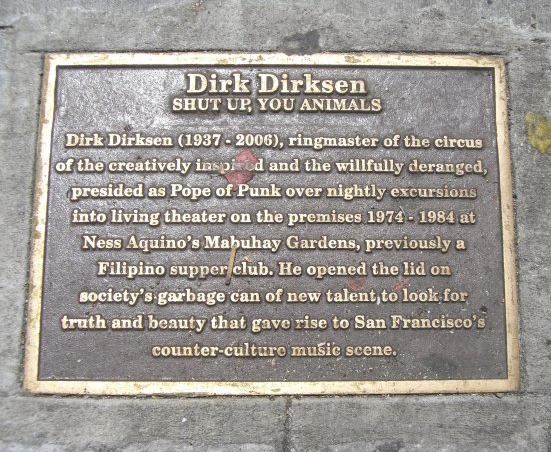
Dirk Dirksen August 25, 1937 – November 20, 2006

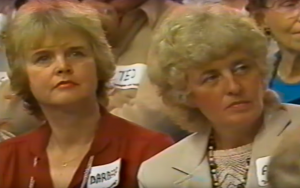
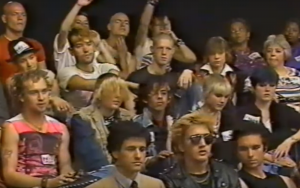
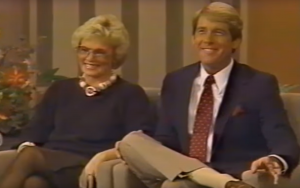
Recent Comments